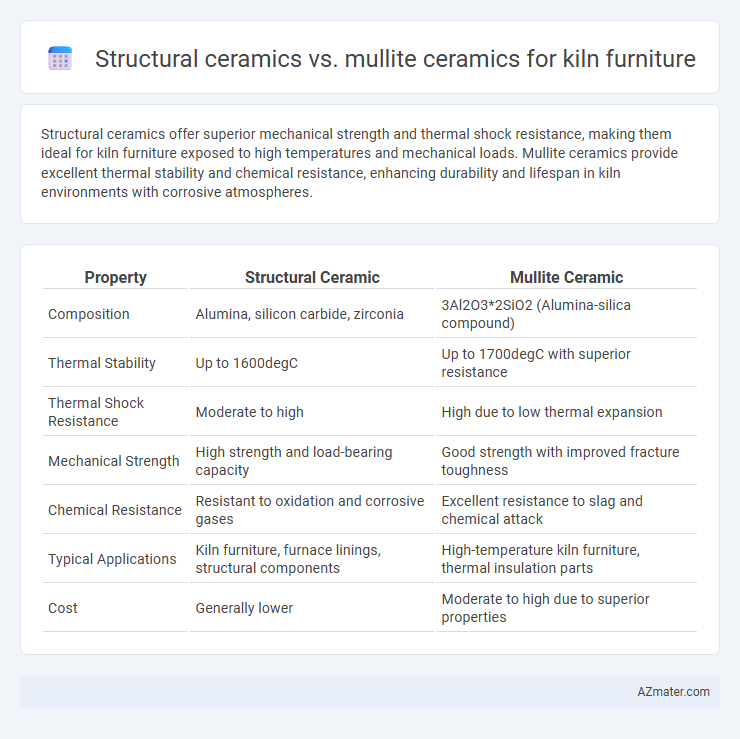Structural ceramics offer superior mechanical strength and thermal shock resistance, making them ideal for kiln furniture exposed to high temperatures and mechanical loads. Mullite ceramics provide excellent thermal stability and chemical resistance, enhancing durability and lifespan in kiln environments with corrosive atmospheres.
Table of Comparison
| Property | Structural Ceramic | Mullite Ceramic |
|---|---|---|
| Composition | Alumina, silicon carbide, zirconia | 3Al2O3*2SiO2 (Alumina-silica compound) |
| Thermal Stability | Up to 1600degC | Up to 1700degC with superior resistance |
| Thermal Shock Resistance | Moderate to high | High due to low thermal expansion |
| Mechanical Strength | High strength and load-bearing capacity | Good strength with improved fracture toughness |
| Chemical Resistance | Resistant to oxidation and corrosive gases | Excellent resistance to slag and chemical attack |
| Typical Applications | Kiln furniture, furnace linings, structural components | High-temperature kiln furniture, thermal insulation parts |
| Cost | Generally lower | Moderate to high due to superior properties |
Introduction to Kiln Furniture Materials
Kiln furniture materials must withstand extreme temperatures and thermal shock, where structural ceramics offer superior mechanical strength and durability under high stress conditions. Mullite ceramics, composed primarily of aluminum silicate, provide excellent thermal stability and resistance to chemical corrosion, making them ideal for insulating applications within kiln environments. Selecting between structural ceramics and mullite depends on the specific thermal load, mechanical demands, and chemical exposure encountered during the firing process.
Overview of Structural Ceramics
Structural ceramics used in kiln furniture typically exhibit high mechanical strength, thermal stability, and resistance to thermal shock, making them ideal for supporting heavy loads at elevated temperatures. Mullite ceramic, a common structural ceramic, offers excellent creep resistance and low thermal expansion due to its unique alumino-silicate composition with a melting point around 1840degC. These properties enable mullite ceramics to maintain dimensional stability and durability in harsh kiln environments, outperforming many traditional structural ceramics in longevity and thermal performance.
Understanding Mullite Ceramics
Mullite ceramics, composed primarily of 3Al2O3*2SiO2, exhibit superior thermal stability and low thermal expansion, making them ideal for kiln furniture in high-temperature applications compared to general structural ceramics. Their exceptional resistance to thermal shock and chemical corrosion enhances durability during repeated firing cycles, crucial for maintaining kiln efficiency and product quality. The inherent properties of mullite, such as high creep resistance and mechanical strength at elevated temperatures, ensure longer service life and reduced maintenance costs in industrial kiln environments.
Key Properties Comparison: Structural vs Mullite Ceramics
Structural ceramics offer exceptional mechanical strength and thermal shock resistance essential for kiln furniture, while mullite ceramics provide superior thermal stability and low thermal expansion, reducing deformation at high temperatures. Mullite, with its high alumina and silica content, exhibits better chemical resistance and creep resistance compared to general structural ceramics. The choice between structural and mullite ceramics depends on balancing the need for durability under mechanical stress versus enduring prolonged exposure to extreme kiln temperatures.
Thermal Performance and Resistance
Structural ceramics and Mullite ceramics both offer high thermal stability, but Mullite ceramic excels with superior thermal shock resistance and lower thermal expansion, making it ideal for kiln furniture exposed to rapid temperature changes. Mullite's low thermal conductivity enhances insulation, reducing heat loss and improving energy efficiency during firing processes. While structural ceramics provide mechanical strength, Mullite's balanced combination of thermal performance and resistance to chemical attack ensures longer service life in harsh kiln environments.
Mechanical Strength and Durability
Structural ceramics, such as alumina and silicon carbide, offer superior mechanical strength with high flexural strength values typically ranging from 300 to 600 MPa, making them ideal for heavy-load kiln furniture applications. Mullite ceramics exhibit excellent thermal shock resistance and moderate strength, typically around 150 to 300 MPa, with enhanced durability in oxidizing environments due to their low thermal expansion coefficient. The choice between structural and mullite ceramics depends on specific kiln conditions, where structural ceramics provide higher mechanical robustness, while mullite offers improved thermal stability and longevity under cycling temperatures.
Weight and Load-Bearing Capabilities
Structural ceramics used in kiln furniture offer superior weight resistance and load-bearing capabilities compared to Mullite ceramics, which are lighter but exhibit lower mechanical strength. Mullite ceramics, while beneficial for thermal insulation due to their low density, tend to have reduced structural integrity under high load conditions. Choosing between the two materials depends on the specific kiln application requirements, balancing the need for weight reduction against the necessity for robust support during firing processes.
Cost Efficiency and Longevity
Structural ceramics offer high mechanical strength and thermal shock resistance, making them ideal for kiln furniture subjected to intense heat cycles, but their cost is generally higher. Mullite ceramics provide excellent thermal stability and resistance to chemical corrosion at a lower price point, resulting in improved cost efficiency for long-term kiln operations. The longevity of mullite ceramics can exceed that of many structural ceramics under typical kiln conditions due to their superior thermal expansion compatibility and erosion resistance.
Application Suitability in Kiln Environments
Structural ceramics offer high mechanical strength and thermal shock resistance, making them suitable for heavy-duty kiln furniture exposed to rapid temperature changes. Mullite ceramics excel in withstanding extreme temperatures above 1600degC and show excellent chemical stability against kiln atmospheres, ideal for continuous high-temperature applications. The choice depends on the specific firing temperature and mechanical load, with mullite preferred in ultra-high temperature environments and structural ceramics favored for robust, versatile kiln supports.
Which Ceramic is Best for Your Kiln Furniture Needs?
Structural ceramics offer superior mechanical strength and thermal shock resistance, making them ideal for high-stress kiln furniture applications. Mullite ceramic excels in high-temperature stability and low thermal expansion, providing excellent durability and consistent performance in prolonged firing cycles. Choosing between structural and mullite ceramics depends on your kiln's operating temperature and load requirements, with mullite preferred for extreme heat and structural ceramics favored for heavy-duty support.

Infographic: Structural ceramic vs Mullite ceramic for Kiln furniture
 azmater.com
azmater.com